Research Proposal: IoT's Impact on Sainsbury's Operations in UK Retail
VerifiedAdded on 2020/12/30
|6
|1853
|348
Report
AI Summary
This research proposal investigates the role of the Internet of Things (IoT) in enhancing operations within the UK retail sector, specifically focusing on Sainsbury's. The study aims to analyze how IoT influences Sainsbury's operations, assess its importance, and recommend improvements. Employing a qualitative research approach, the research will utilize an inductive approach and interpretivism philosophy. Data collection methods include questionnaires administered to 30 Sainsbury's personnel and a review of secondary sources such as books and journal articles. The research will employ purposive sampling and exploratory research design, with data analysis conducted using thematic perception tests. Ethical considerations include obtaining prior consent, and limitations include a small sample size. The research timeline spans 12 months, covering topic selection, proposal development, data collection, analysis, and final submission.

Research Proposal Form
Student Name:
Student Number:
Centre Name:
Tutor:
Date:
Unit:
Proposed title:
Student Name:
Student Number:
Centre Name:
Tutor:
Date:
Unit:
Proposed title:
Paraphrase This Document
Need a fresh take? Get an instant paraphrase of this document with our AI Paraphraser
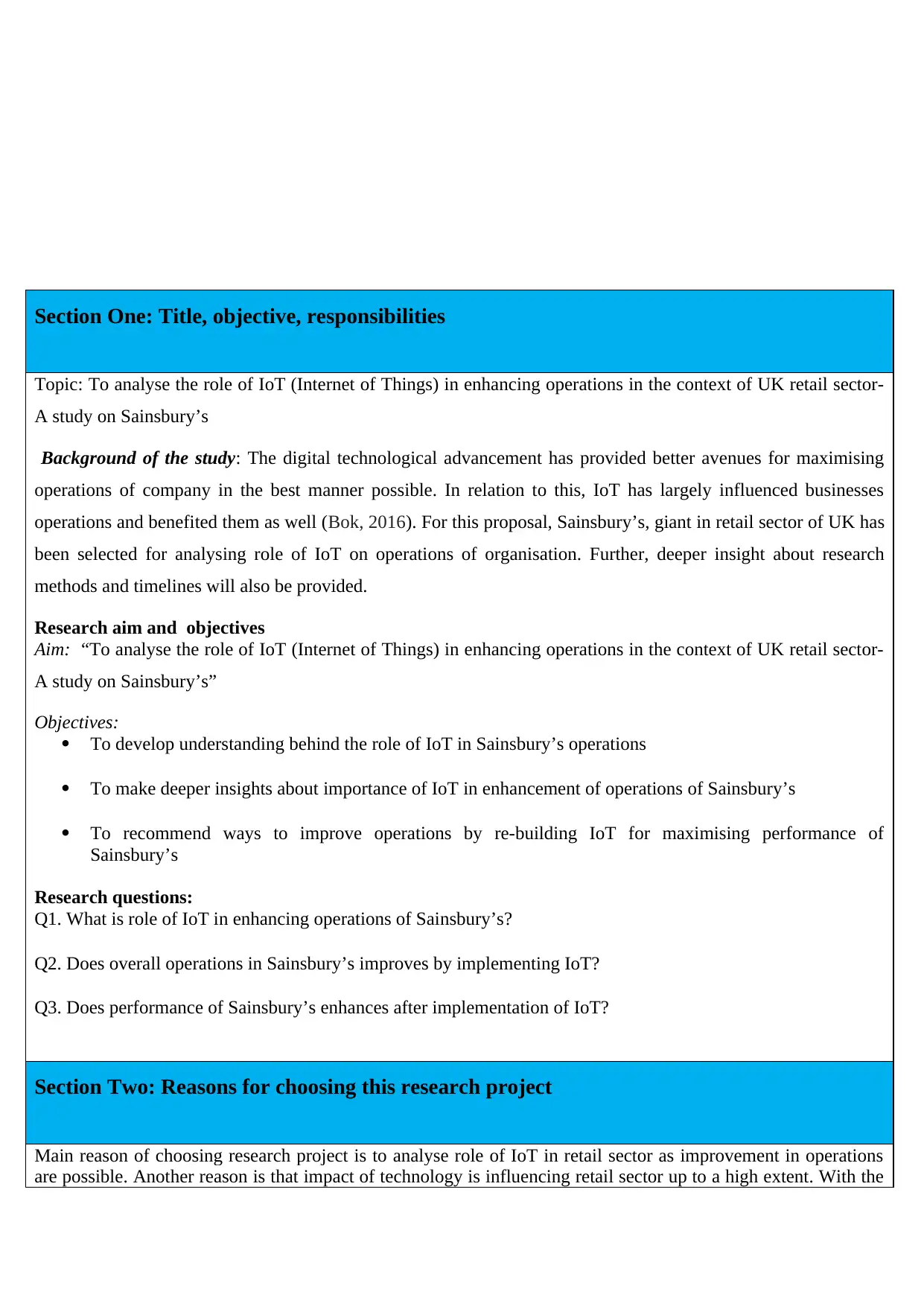
Section One: Title, objective, responsibilities
Topic: To analyse the role of IoT (Internet of Things) in enhancing operations in the context of UK retail sector-
A study on Sainsbury’s
Background of the study: The digital technological advancement has provided better avenues for maximising
operations of company in the best manner possible. In relation to this, IoT has largely influenced businesses
operations and benefited them as well (Bok, 2016). For this proposal, Sainsbury’s, giant in retail sector of UK has
been selected for analysing role of IoT on operations of organisation. Further, deeper insight about research
methods and timelines will also be provided.
Research aim and objectives
Aim: “To analyse the role of IoT (Internet of Things) in enhancing operations in the context of UK retail sector-
A study on Sainsbury’s”
Objectives:
To develop understanding behind the role of IoT in Sainsbury’s operations
To make deeper insights about importance of IoT in enhancement of operations of Sainsbury’s
To recommend ways to improve operations by re-building IoT for maximising performance of
Sainsbury’s
Research questions:
Q1. What is role of IoT in enhancing operations of Sainsbury’s?
Q2. Does overall operations in Sainsbury’s improves by implementing IoT?
Q3. Does performance of Sainsbury’s enhances after implementation of IoT?
Section Two: Reasons for choosing this research project
Main reason of choosing research project is to analyse role of IoT in retail sector as improvement in operations
are possible. Another reason is that impact of technology is influencing retail sector up to a high extent. With the
Topic: To analyse the role of IoT (Internet of Things) in enhancing operations in the context of UK retail sector-
A study on Sainsbury’s
Background of the study: The digital technological advancement has provided better avenues for maximising
operations of company in the best manner possible. In relation to this, IoT has largely influenced businesses
operations and benefited them as well (Bok, 2016). For this proposal, Sainsbury’s, giant in retail sector of UK has
been selected for analysing role of IoT on operations of organisation. Further, deeper insight about research
methods and timelines will also be provided.
Research aim and objectives
Aim: “To analyse the role of IoT (Internet of Things) in enhancing operations in the context of UK retail sector-
A study on Sainsbury’s”
Objectives:
To develop understanding behind the role of IoT in Sainsbury’s operations
To make deeper insights about importance of IoT in enhancement of operations of Sainsbury’s
To recommend ways to improve operations by re-building IoT for maximising performance of
Sainsbury’s
Research questions:
Q1. What is role of IoT in enhancing operations of Sainsbury’s?
Q2. Does overall operations in Sainsbury’s improves by implementing IoT?
Q3. Does performance of Sainsbury’s enhances after implementation of IoT?
Section Two: Reasons for choosing this research project
Main reason of choosing research project is to analyse role of IoT in retail sector as improvement in operations
are possible. Another reason is that impact of technology is influencing retail sector up to a high extent. With the
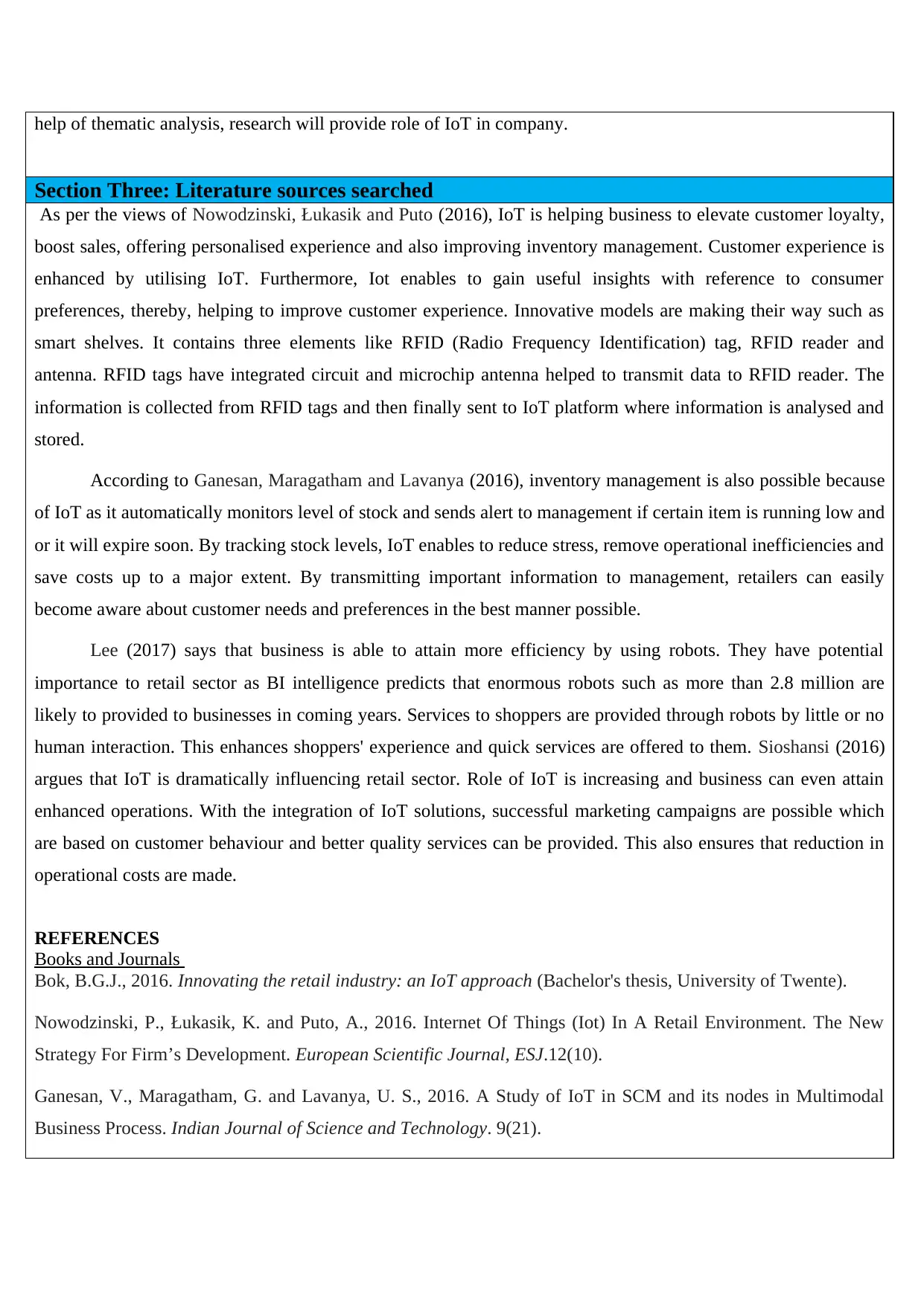
help of thematic analysis, research will provide role of IoT in company.
Section Three: Literature sources searched
As per the views of Nowodzinski, Łukasik and Puto (2016), IoT is helping business to elevate customer loyalty,
boost sales, offering personalised experience and also improving inventory management. Customer experience is
enhanced by utilising IoT. Furthermore, Iot enables to gain useful insights with reference to consumer
preferences, thereby, helping to improve customer experience. Innovative models are making their way such as
smart shelves. It contains three elements like RFID (Radio Frequency Identification) tag, RFID reader and
antenna. RFID tags have integrated circuit and microchip antenna helped to transmit data to RFID reader. The
information is collected from RFID tags and then finally sent to IoT platform where information is analysed and
stored.
According to Ganesan, Maragatham and Lavanya (2016), inventory management is also possible because
of IoT as it automatically monitors level of stock and sends alert to management if certain item is running low and
or it will expire soon. By tracking stock levels, IoT enables to reduce stress, remove operational inefficiencies and
save costs up to a major extent. By transmitting important information to management, retailers can easily
become aware about customer needs and preferences in the best manner possible.
Lee (2017) says that business is able to attain more efficiency by using robots. They have potential
importance to retail sector as BI intelligence predicts that enormous robots such as more than 2.8 million are
likely to provided to businesses in coming years. Services to shoppers are provided through robots by little or no
human interaction. This enhances shoppers' experience and quick services are offered to them. Sioshansi (2016)
argues that IoT is dramatically influencing retail sector. Role of IoT is increasing and business can even attain
enhanced operations. With the integration of IoT solutions, successful marketing campaigns are possible which
are based on customer behaviour and better quality services can be provided. This also ensures that reduction in
operational costs are made.
REFERENCES
Books and Journals
Bok, B.G.J., 2016. Innovating the retail industry: an IoT approach (Bachelor's thesis, University of Twente).
Nowodzinski, P., Łukasik, K. and Puto, A., 2016. Internet Of Things (Iot) In A Retail Environment. The New
Strategy For Firm’s Development. European Scientific Journal, ESJ.12(10).
Ganesan, V., Maragatham, G. and Lavanya, U. S., 2016. A Study of IoT in SCM and its nodes in Multimodal
Business Process. Indian Journal of Science and Technology. 9(21).
Section Three: Literature sources searched
As per the views of Nowodzinski, Łukasik and Puto (2016), IoT is helping business to elevate customer loyalty,
boost sales, offering personalised experience and also improving inventory management. Customer experience is
enhanced by utilising IoT. Furthermore, Iot enables to gain useful insights with reference to consumer
preferences, thereby, helping to improve customer experience. Innovative models are making their way such as
smart shelves. It contains three elements like RFID (Radio Frequency Identification) tag, RFID reader and
antenna. RFID tags have integrated circuit and microchip antenna helped to transmit data to RFID reader. The
information is collected from RFID tags and then finally sent to IoT platform where information is analysed and
stored.
According to Ganesan, Maragatham and Lavanya (2016), inventory management is also possible because
of IoT as it automatically monitors level of stock and sends alert to management if certain item is running low and
or it will expire soon. By tracking stock levels, IoT enables to reduce stress, remove operational inefficiencies and
save costs up to a major extent. By transmitting important information to management, retailers can easily
become aware about customer needs and preferences in the best manner possible.
Lee (2017) says that business is able to attain more efficiency by using robots. They have potential
importance to retail sector as BI intelligence predicts that enormous robots such as more than 2.8 million are
likely to provided to businesses in coming years. Services to shoppers are provided through robots by little or no
human interaction. This enhances shoppers' experience and quick services are offered to them. Sioshansi (2016)
argues that IoT is dramatically influencing retail sector. Role of IoT is increasing and business can even attain
enhanced operations. With the integration of IoT solutions, successful marketing campaigns are possible which
are based on customer behaviour and better quality services can be provided. This also ensures that reduction in
operational costs are made.
REFERENCES
Books and Journals
Bok, B.G.J., 2016. Innovating the retail industry: an IoT approach (Bachelor's thesis, University of Twente).
Nowodzinski, P., Łukasik, K. and Puto, A., 2016. Internet Of Things (Iot) In A Retail Environment. The New
Strategy For Firm’s Development. European Scientific Journal, ESJ.12(10).
Ganesan, V., Maragatham, G. and Lavanya, U. S., 2016. A Study of IoT in SCM and its nodes in Multimodal
Business Process. Indian Journal of Science and Technology. 9(21).
⊘ This is a preview!⊘
Do you want full access?
Subscribe today to unlock all pages.

Trusted by 1+ million students worldwide
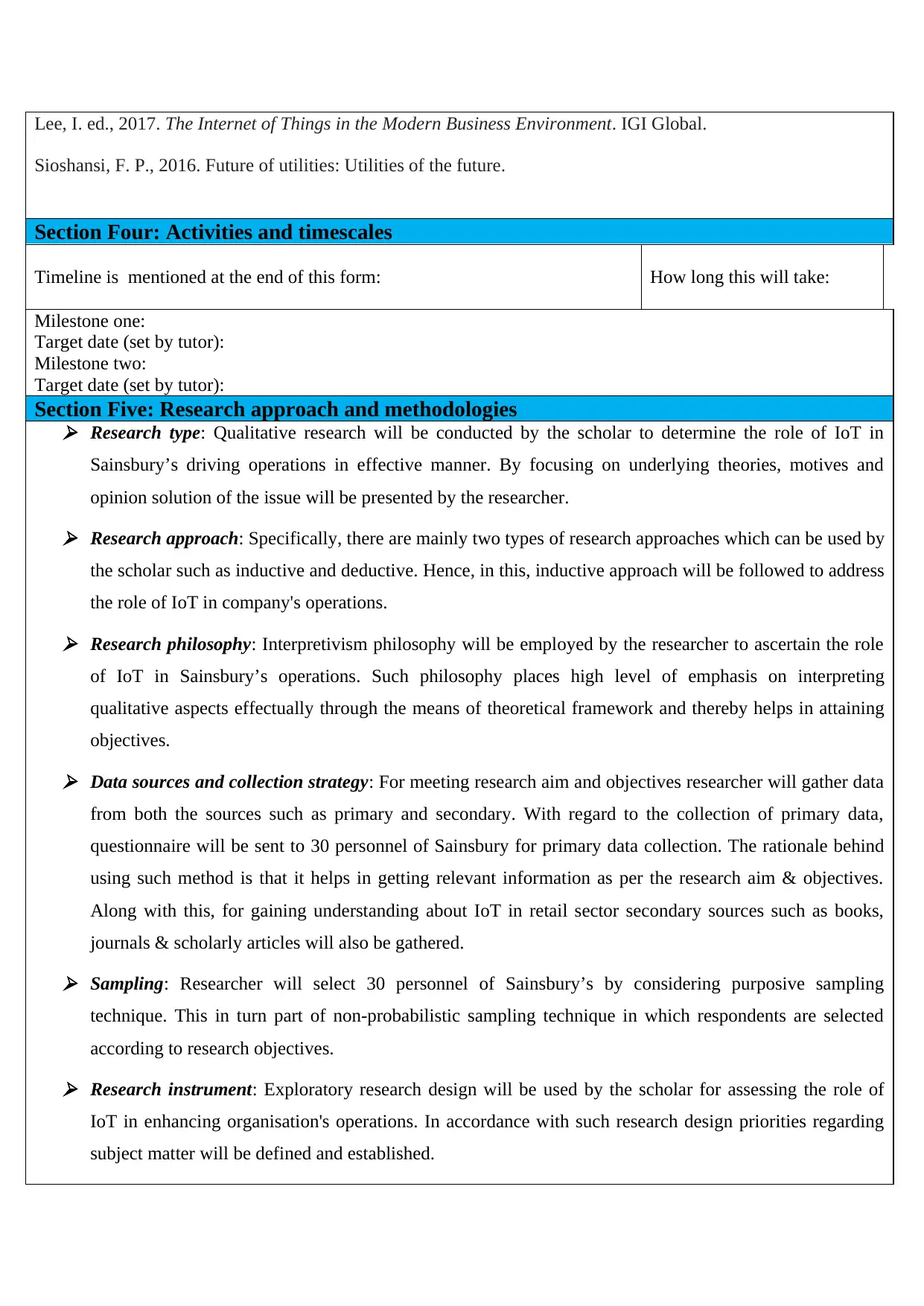
Lee, I. ed., 2017. The Internet of Things in the Modern Business Environment. IGI Global.
Sioshansi, F. P., 2016. Future of utilities: Utilities of the future.
Section Four: Activities and timescales
Timeline is mentioned at the end of this form: How long this will take:
Milestone one:
Target date (set by tutor):
Milestone two:
Target date (set by tutor):
Section Five: Research approach and methodologies Research type: Qualitative research will be conducted by the scholar to determine the role of IoT in
Sainsbury’s driving operations in effective manner. By focusing on underlying theories, motives and
opinion solution of the issue will be presented by the researcher.
Research approach: Specifically, there are mainly two types of research approaches which can be used by
the scholar such as inductive and deductive. Hence, in this, inductive approach will be followed to address
the role of IoT in company's operations.
Research philosophy: Interpretivism philosophy will be employed by the researcher to ascertain the role
of IoT in Sainsbury’s operations. Such philosophy places high level of emphasis on interpreting
qualitative aspects effectually through the means of theoretical framework and thereby helps in attaining
objectives.
Data sources and collection strategy: For meeting research aim and objectives researcher will gather data
from both the sources such as primary and secondary. With regard to the collection of primary data,
questionnaire will be sent to 30 personnel of Sainsbury for primary data collection. The rationale behind
using such method is that it helps in getting relevant information as per the research aim & objectives.
Along with this, for gaining understanding about IoT in retail sector secondary sources such as books,
journals & scholarly articles will also be gathered.
Sampling: Researcher will select 30 personnel of Sainsbury’s by considering purposive sampling
technique. This in turn part of non-probabilistic sampling technique in which respondents are selected
according to research objectives.
Research instrument: Exploratory research design will be used by the scholar for assessing the role of
IoT in enhancing organisation's operations. In accordance with such research design priorities regarding
subject matter will be defined and established.
Sioshansi, F. P., 2016. Future of utilities: Utilities of the future.
Section Four: Activities and timescales
Timeline is mentioned at the end of this form: How long this will take:
Milestone one:
Target date (set by tutor):
Milestone two:
Target date (set by tutor):
Section Five: Research approach and methodologies Research type: Qualitative research will be conducted by the scholar to determine the role of IoT in
Sainsbury’s driving operations in effective manner. By focusing on underlying theories, motives and
opinion solution of the issue will be presented by the researcher.
Research approach: Specifically, there are mainly two types of research approaches which can be used by
the scholar such as inductive and deductive. Hence, in this, inductive approach will be followed to address
the role of IoT in company's operations.
Research philosophy: Interpretivism philosophy will be employed by the researcher to ascertain the role
of IoT in Sainsbury’s operations. Such philosophy places high level of emphasis on interpreting
qualitative aspects effectually through the means of theoretical framework and thereby helps in attaining
objectives.
Data sources and collection strategy: For meeting research aim and objectives researcher will gather data
from both the sources such as primary and secondary. With regard to the collection of primary data,
questionnaire will be sent to 30 personnel of Sainsbury for primary data collection. The rationale behind
using such method is that it helps in getting relevant information as per the research aim & objectives.
Along with this, for gaining understanding about IoT in retail sector secondary sources such as books,
journals & scholarly articles will also be gathered.
Sampling: Researcher will select 30 personnel of Sainsbury’s by considering purposive sampling
technique. This in turn part of non-probabilistic sampling technique in which respondents are selected
according to research objectives.
Research instrument: Exploratory research design will be used by the scholar for assessing the role of
IoT in enhancing organisation's operations. In accordance with such research design priorities regarding
subject matter will be defined and established.
Paraphrase This Document
Need a fresh take? Get an instant paraphrase of this document with our AI Paraphraser
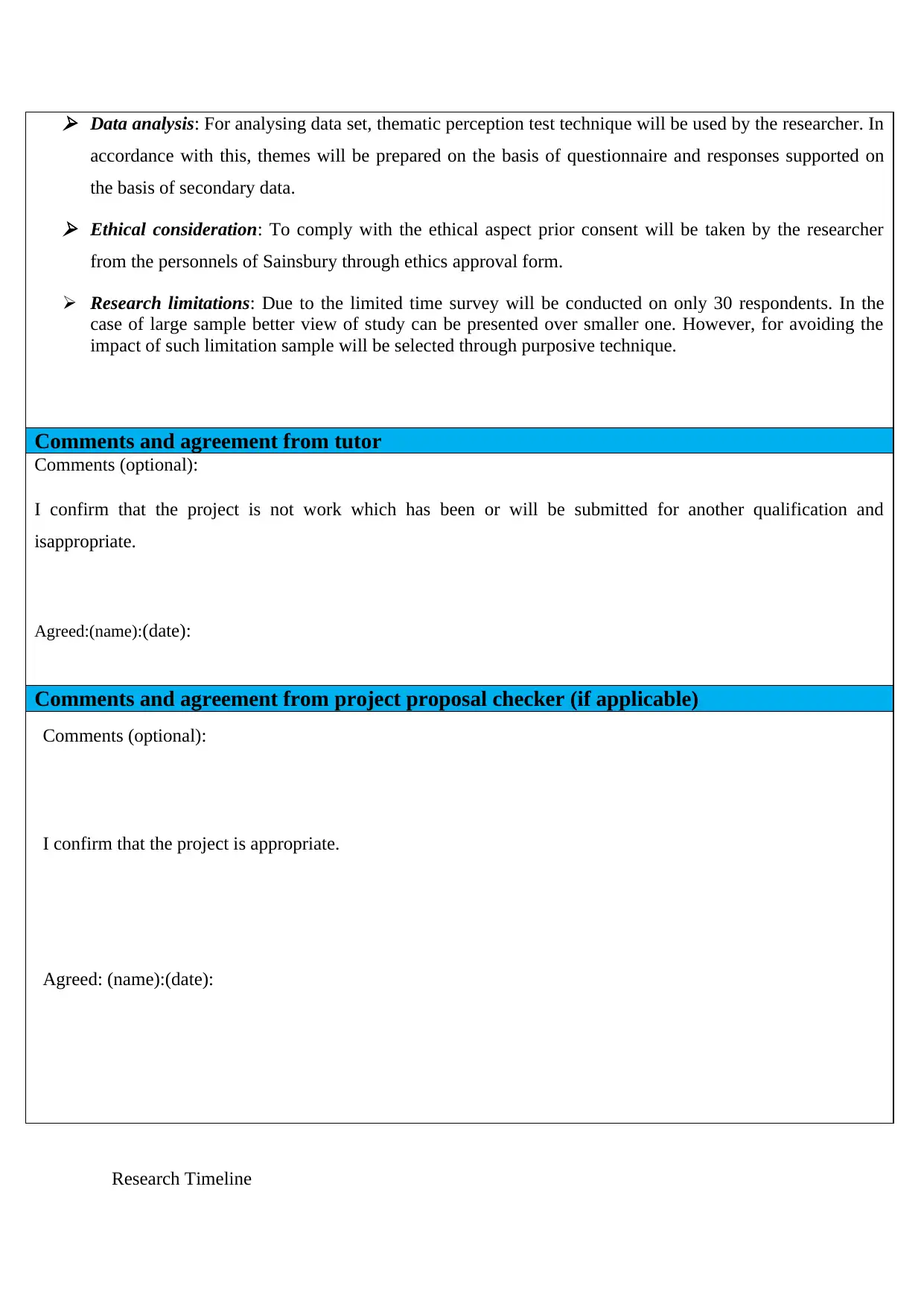
Data analysis: For analysing data set, thematic perception test technique will be used by the researcher. In
accordance with this, themes will be prepared on the basis of questionnaire and responses supported on
the basis of secondary data.
Ethical consideration: To comply with the ethical aspect prior consent will be taken by the researcher
from the personnels of Sainsbury through ethics approval form.
Research limitations: Due to the limited time survey will be conducted on only 30 respondents. In the
case of large sample better view of study can be presented over smaller one. However, for avoiding the
impact of such limitation sample will be selected through purposive technique.
Comments and agreement from tutor
Comments (optional):
I confirm that the project is not work which has been or will be submitted for another qualification and
isappropriate.
Agreed:(name):(date):
Comments and agreement from project proposal checker (if applicable)
Comments (optional):
I confirm that the project is appropriate.
Agreed: (name):(date):
Research Timeline
accordance with this, themes will be prepared on the basis of questionnaire and responses supported on
the basis of secondary data.
Ethical consideration: To comply with the ethical aspect prior consent will be taken by the researcher
from the personnels of Sainsbury through ethics approval form.
Research limitations: Due to the limited time survey will be conducted on only 30 respondents. In the
case of large sample better view of study can be presented over smaller one. However, for avoiding the
impact of such limitation sample will be selected through purposive technique.
Comments and agreement from tutor
Comments (optional):
I confirm that the project is not work which has been or will be submitted for another qualification and
isappropriate.
Agreed:(name):(date):
Comments and agreement from project proposal checker (if applicable)
Comments (optional):
I confirm that the project is appropriate.
Agreed: (name):(date):
Research Timeline
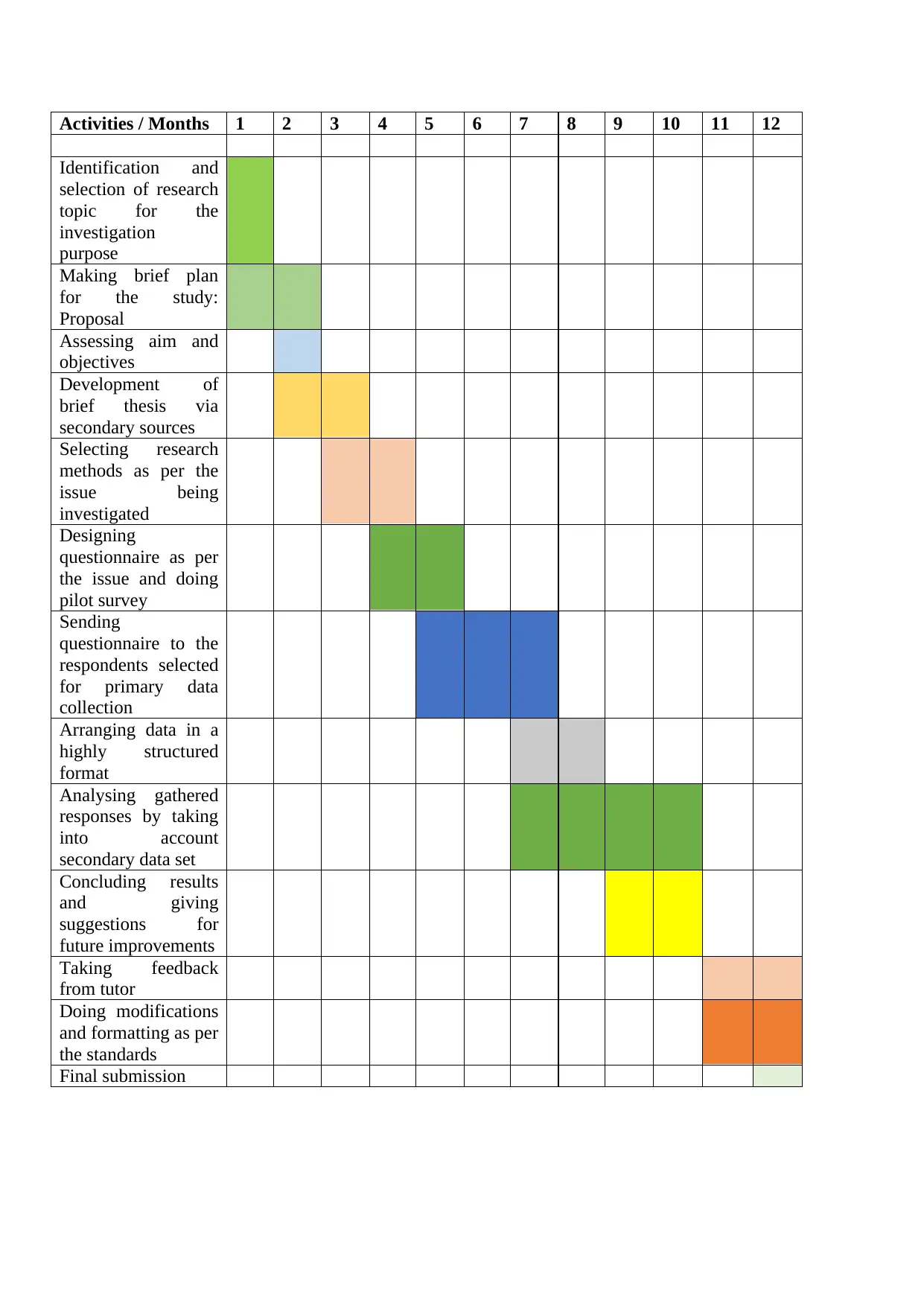
Activities / Months 1 2 3 4 5 6 7 8 9 10 11 12
Identification and
selection of research
topic for the
investigation
purpose
Making brief plan
for the study:
Proposal
Assessing aim and
objectives
Development of
brief thesis via
secondary sources
Selecting research
methods as per the
issue being
investigated
Designing
questionnaire as per
the issue and doing
pilot survey
Sending
questionnaire to the
respondents selected
for primary data
collection
Arranging data in a
highly structured
format
Analysing gathered
responses by taking
into account
secondary data set
Concluding results
and giving
suggestions for
future improvements
Taking feedback
from tutor
Doing modifications
and formatting as per
the standards
Final submission
Identification and
selection of research
topic for the
investigation
purpose
Making brief plan
for the study:
Proposal
Assessing aim and
objectives
Development of
brief thesis via
secondary sources
Selecting research
methods as per the
issue being
investigated
Designing
questionnaire as per
the issue and doing
pilot survey
Sending
questionnaire to the
respondents selected
for primary data
collection
Arranging data in a
highly structured
format
Analysing gathered
responses by taking
into account
secondary data set
Concluding results
and giving
suggestions for
future improvements
Taking feedback
from tutor
Doing modifications
and formatting as per
the standards
Final submission
⊘ This is a preview!⊘
Do you want full access?
Subscribe today to unlock all pages.

Trusted by 1+ million students worldwide
1 out of 6
Related Documents
Your All-in-One AI-Powered Toolkit for Academic Success.
+13062052269
info@desklib.com
Available 24*7 on WhatsApp / Email
![[object Object]](/_next/static/media/star-bottom.7253800d.svg)
Unlock your academic potential
Copyright © 2020–2025 A2Z Services. All Rights Reserved. Developed and managed by ZUCOL.




